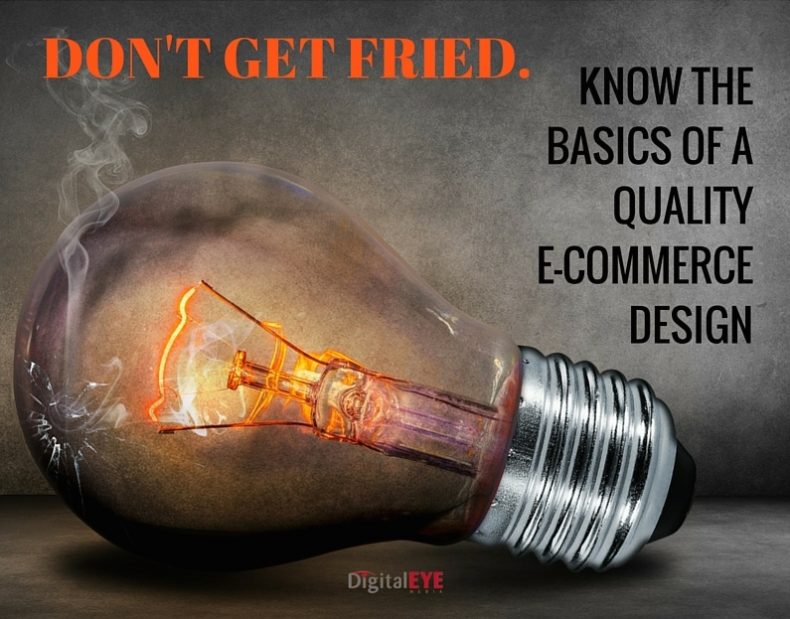Quality E-Commerce Web Design: Know The Basics
E-commerce has its hand in nearly every part of daily life today. You would almost need to live off the grid to get away from its influence – which is great news if you aspire to launch an online store or already have an online enterprise that is up and running. Yet too many talented entrepreneurs still lack understanding of what it takes to improve an e-commerce store to the point where good results become great.
In this post, learn the basics of high quality e-commerce web design so you can achieve your sales goals.
4 Types of E-Commerce Models
Did you know there are actually four different e-commerce models? Your particular online store may fall into one specific niche model or include all four. It is very helpful to figure out where you fit to be sure your e-commerce website is a good match for your customer base.
Here are the 4 basic categories: 
- Business to Consumer: This is the most common model and the one most people know best. Here, a business launches an online store with the goal of selling products and/or services directly to customers.
- Business to Business: This is probably the second most common model (at least in terms of name awareness). With this model, a business sells products and/or services to other businesses, typically either as raw materials or as products for resale.
- Consumer to Business: The consumer to business model has become more popular as more and more solopreneurs launch their own online stores. With this model, a consumer with an attractive, successful product or a service aptitude markets towards businesses. A good example is when an indie author gets their self-published book included in a holiday retail mail order catalog.
- Consumer to Consumer: This last model is the least well known but is commonly practiced. The goal here is to connect consumers who want to buy directly with other consumers who have something they want to sell. The popularity of online platforms like eBay and Facebook groups is an excellent example of this model in action.
Designing an Appealing E-Commerce Website
Once you understand which model(s) your e-commerce site must appeal to, you can get to work designing and refining your platform. Here are the basic tips to keep in mind as you work to create your online vision.
Responsive Design.
The word “responsive” is actually code for “mobile-friendly.” Depending on which source you consult, up to 90 percent of all shoppers will consult their mobile device as part of the browsing-to-buying process.
Even for shoppers who ultimately make a purchase at a brick-and-mortar store, they may order the item online and have it shipped, do online price comparisons, clip digital coupons and other online activities that can take them to (and from) your e-commerce store.
So if your e-commerce site is not optimized for small screen devices, this is your first order of business!
Secure Shopping Experience.
Think of the last time you shopped online. Did you feel even a twinge of concern about whether it was safe to enter your credit card data to check out? If the answer is yes, you probably didn’t make a purchase from that site. If the answer is no, you probably felt secure enough just from the site’s appearance to not question the store’s commitment to securing your sensitive financial data.
Using SSL (secure socket layer) encryption (this will result in a lock icon in the browser bar and a change from “http” to “https” at checkout), posting badges from third party security companies such as McAfee or Norton, taking the precaution of posting a message to let your customers know you take their security very seriously and other aids can ease even the most concerned customer’s mind.
For those customers who are still very wary, providing a phone number or mailing address for an alternate means of ordering can be very helpful in building trust.
Relevant Colors and Images.
When you select the colors and images that will display on each page of your e-commerce website, you want to be sure they are consistent with two things:
Your Brand and Logo Colors. You want to achieve consistency of image everywhere your brand is online. This is best achieved by choosing colors to match those of your brand and logo. When browsers can identify your brand just by the color scheme, you know you have done an excellent job here.
Your Product or Service. The type of product or service you are offering should factor greatly into the color scheme and design of your e-commerce website. For example, you might expect to see a lot of greens and reds on a site devoted to selling fresh tasty produce. When visitors can guess correctly at what you are selling just by surveying your site colors, you know you have achieved this goal.
Simple Navigation.
Today’s online shoppers have a tremendous range of options and plenty of places to shop online – and they know it. Complicate their online experience in any way and you can be sure they will disappear from your site faster than you can say “bounce.”
Evaluate your e-commerce site for each of the following:
- Simple, clear, easy to read text in a font size suitable for any age eyes.
- An effortless layout that is mentally logical to follow.
- Clear navigation that takes visitors from wherever they land (your home page or landing page) to your checkout page as quickly as possible.
As you continue to evaluate, test and refine your e-commerce website, you will be able to use Google Analytics (or your reporting tool of choice) to see how each change affects your site’s effectiveness. Your patience and perseverance will give you the knowledge to build an e-commerce web site that truly appeals to both existing and new customers.











